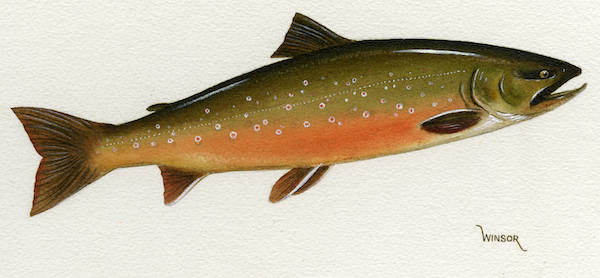Arctic char is depicted in this illustration. (Illustration by Don Winsor/Alaska Department of Fish and Game)
In the heat of debate over salmon farming, Alaska banned all finfish farming, except for a very narrow window for goldfish and other pet store varieties. As Alaska seeks ways to diversify its economy, it is time to rethink the overreach of the ban. Here’s a modest proposal that could result in small-scale, affordable enterprises utilizing existing renewable resources.
How fish farming can be no threat
Under our proposal, no saltwater farming would be allowed, and the amended law would specifically prohibit rearing of Pacific and Atlantic salmon in fresh water. These measures should remove the concerns raised by commercial fishermen and environmental groups during the debate over salmon farming.
Also prevented would be the farming of commercial species such as halibut and black cod in upland tanks.
While arctic char is a distant cousin of salmon, farmed and wild caught char does not compete in the markets for salmon. Most of Canada’s production of char is consumed in country. Iceland is the leading producer of char, which is consumed mostly in northern Europe.
The Monterey Bay Aquarium Seafood Watch program promotes farmed Arctic char as an environmentally sustainable best choice for consumers, stating: “Arctic char use only a moderate amount of marine resources for feed” and that they “are farmed in land-based, closed systems that minimize the risk of escape into the wild.”
The farming of freshwater finfish, such as arctic char, sheefish, rainbow trout and even tilapia, in upland tanks or enclosed lakes or ponds could provide jobs and increase food security without harming the environment or threatening wild stocks. Unlike the drive to expand oil and gas production and large-scale mining working with multinational corporations which reap most of the benefits, freshwater fish farming could appeal more to smaller Alaska-owned businesses.
Alaska clearly has an abundance of freshwater resources, and experience in Alaska’s premier state hatchery and a Whitehorse fish farm show that arctic char and sheefish prefer cool rearing waters. In addition, arctic char and sheefish can be raised in high densities without experiencing significant problems with disease.
Icy Waters near Whitehorse has farmed arctic char for about three decades and has found the preferred water temperature is below 12 C (53.6 F) and the fish could survive and feed in water temperatures as low as 1 C (33.8 F). Icy Waters also experimented with keeping char in a lake over winter and found that the fish could survive under winter ice without feeding until spring.
The experience of the Alaska Department of Fish and Game’s William Jack Hernandez Sportfish Hatchery in Anchorage in raising char is like Icy Waters. Both facilities have found char:
are calm and non-aggressive;
prefer densities of 50-70 kilograms per cubic meter (110-154 pounds per cubic meter of water) and can survive in densities of more than 200 pounds per cubic meter of water (these are much higher than salmon);
can survive high density rearing, prefer cool waters and experience very low rates of disease (no medications or chemical treatments are used at either facility); and
the species have high fecundity (4-5,000 eggs/female in Alaska and up to 10,000 eggs in older females held in Icy Waters).
While there is less experience with sheefish, the Hernandez hatchery shows the species also can survive high-density rearing, prefers cool waters and experiences low rates of disease.
Arctic char is an important commercial and subsistence species across Siberia, Alaska, Canada, Iceland and Scandinavia. Estimated global production of farmed char ranges between 6,000-10,000 tons. Recent online U.S. prices for char range from $17 to $28 per pound.
Char and sheefish appear to be particularly suitable for farming in northwestern Alaska waters. These are stocks that have long been a mainstay in the diets of Native residents in the areas hit so hard with the disappearance of salmon. The farms could provide revenues for the stocking of local streams and lakes, in addition to producing high-quality sources of protein.
Release of stocks will require production of triploid fish, which are considered functionally sterile.
All freshwater finfish farming will require a lot of work because farms will require hatchery status as access to wild stocks will be difficult and state agencies aren’t geared to help assist smaller-scale startups. Aquaculture enterprises throughout the world all require government support and encouragement to thrive.
Other species might have more obstacles than char and sheefish because most will require warmer rearing waters and may have more problems with disease, rainbow trout as an example.
Tilapia is a great partner for vertical aquaponics, or the growing of vegetables in water rather than soil. The combination of these two methods results in a mutually beneficial relationship where fish waste provides nutrients for the plants and the plants purify the water for the fish. The sale of tilapia could add an important source of revenue to the operation.
In the mid-1990s, a couple of young men approached an officer of the Alaskan Shellfish Growers Association and asked about Alaska’s ban on finfish farming as they had successfully raised tilapia in the basement of their Wasilla home. The officer told them changes in the law were unrealistic.
This may be the time to change the law, but it will require a lot of work in the deeply divided Legislature.
GET THE MORNING HEADLINES DELIVERED TO YOUR INBOX

